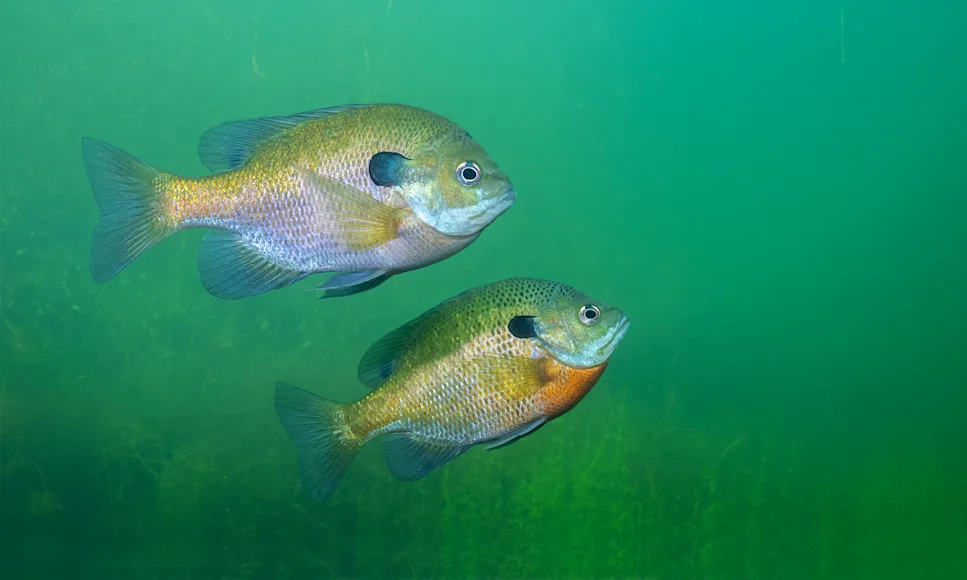What do bluegills eat? In a word, everything. It explains why they have a reputation for being extremely easy to catch, and, therefore, the perfect target for kids. Most of us started out fishing for bluegills—or some other type of sunfish—with a simple worm under a bobber. But have you ever thought about the fact that nightcrawlers aren’t something these fish see in their natural environment? Therein lies the difference between parsing out what a fish will eat and what it usually eats in its natural environment.
We’re going to focus on the latter, as understanding the natural food sources of a bluegill will help you make better choices when procuring bait for an outing. Given that they’re highly opportunistic feeders, you can catch them on bread, worms, hot dog bits, and a slew of other foods they wouldn’t see naturally. Heck, I’ve even seen bluegills caught on a piece of chewed bubblegum and a tiny ball of Play-Doh. But by homing in on natural food sources where you fish—that is, understanding what do bluegills eat—you’ll have a better chance of catching big, palm-sized bluegills versus the little guys that will swarm everything from a fleck of pancake to a Gummy Bear.
Table of Contents: What Do Bluegills Eat?
Aquatic Insects
Terrestrial Insects
Crustaceans
Baitfish
Marine Worms and Leeches
Fish Eggs
Plants, Seeds, and Berries
Mollusks
Aquatic Insects
Much like trout, a bluegill’s diet consists of a lot of aquatic insects. Species like caddisflies, mayflies, and stoneflies lay their eggs in water. When they hatch, that larva lives among the rocks, mud, and submerged vegetation until they mature enough to rise to the surface and fly away. There is some form of aquatic insect larvae available to bluegills practically year-round, even during the winter in many parts of the country.
Terrestrial Insects

Terrestrial insects are those born on land or around water, but not underwater. This includes mosquitos, beetles, ants, and grasshoppers to name a few. While these food sources make up a lower percentage of a bluegill’s diet than aquatic insects, during the warmer months enough of them end up in the lake, pond, or stream to classify them as a key food source for these opportunistic feeders.
Crustaceans
Although they’re not on the radar of many panfish anglers, tiny freshwater shrimp called scuds make up a good portion of a bluegill’s diet and are another example of what bluegill eat. These tiny morsels thrive among aquatic vegetation all year long, making them a particularly important food source during the coldest months of the year. Likewise, bluegill will devour crayfish. Young crayfish measuring less than an inch are preferable given the small size of a bluegills mouth. However, large, trophy-class bluegill have no problem chowing down on much larger specimens.
Baitfish
Given that bluegills love an easy meal like a worm dangling under a bobber, people often forget that these fish are predators. Regardless of their size, bluegills do eat smaller fish, selecting the size of their targets based on what they can catch and consume. For small bluegill, that’s often tiny, juvenile minnows or gamefish still in the fry stage. Big bluegills, of course, can hunt, capture, and swallow baitfish and juvenile fish measuring an inch or more.
Marine Worms and Leeches

In almost every body of freshwater, invertebrates like worn-borne worms and leeches exist. Many are so small they’re practically microscope, but these tiny critters fuel bluegill growth when the fish are very young. Large bluegills do eat leeches, as well as larger roundworms and flatworms.
Fish Eggs
Bluegills are often at their most aggressive during the spawning seasons of other fish like bass and perch within the same body of water. They are notorious egg raiders, sometimes attacking nests in a coordinated assault to distract the larger fish that could potentially eat them. Any fish eggs clinging to aquatic vegetation are also fair game.
Plants, Seeds, and Berries
Bluegills are herbivores, and though it’s primarily young bluegills that dine on aquatic plants, adult fish do eat them as well. Likewise, when certain seeds, berries, or seed pods are shaken or blown into the water, bluegills will gladly become vegetarians while the food source is abundant.
Mollusks
Bluegills have powerful jaws and throat muscles for such small fish, giving them the ability to crack right through the hard shells of freshwater mollusks. Tiny snails that cling to aquatic vegetation in water bodies across the country are a favorite of bluegills of all sizes. Another answer to, “what do bluegill eat,” are freshwater mussels—particularly for larger fish with bigger mouths that can hold and crush them to get at the succulent meat inside.
Continue Reading…
Hungry for more stories about the diets of other fish and game species? Then check out the following on our site:


